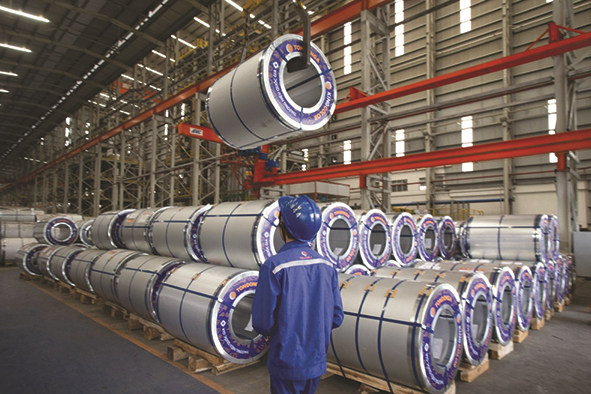New strategies for attracting quality FDI to Việt Nam
 |
| Việt Nam Institute for Economic and Policy Research’s Vice President Nguyễn Quốc Việt |
Robust foreign direct investment (FDI) flows into Việt Nam has become the spotlight of the Vietnamese economy on the backdrop of global slowdown and rising uncertainty. The Government has switched the FDI attraction policies towards quality inflow and sustainable development, pinned by the ambition of becoming a global chip production centre. Việt Nam Institute for Economic and Policy Research’s Vice President Nguyễn Quốc Việt spoke with Việt Nam News reporter Mai Linh on new competitive advantages for Việt Nam to remain an attractive destination for the quality and high technology capital inflow.
What are the opportunities and challenges for Việt Nam in attracting the FDI in the new global context?
We can see that the recovery of the FDI flow is a rare bright spot in a relatively gloomy economic landscape of Việt Nam in which five out of 15 socio-economic indicators are forecast to be missed this year, including 6.5 per cent gross domestic product (GDP) growth target.
Despite concerns that global headwinds are triggering “friend shoring”, which in fact has happened in late 2022, persifying production and supply chains remain a choice for multinational enterprises (MNEs) to disperse risks.
With macro-economic and political stability coupled with a favourable geographical location, Việt Nam arises to be an attractive destination for capital in the context that the geopolitical tensions between major economies is promoting a shift of global supply chains away from China.
Việt Nam has arisen to become one of the 40 largest economies and the top five fastest growing economies in the world after around four decades of reforms.
Việt Nam also provides a gateway to larger markets, including the ASEAN, Northeast Asia and the Pacific regions, as the country is proactively joining bilateral and regional free trade agreements (FTAs).
The appeal also comes from the country’s young population with an abundant workforce and cheap labour.
Việt Nam has drastically implemented institutional reforms and improved the business environment. Outstanding achievements in institutional reforms have helped Việt Nam to facilitate investment – a major push for FDI attraction in the pre-COVID period before a slight slowdown in 2021-22 as the pandemic took a hit.
Việt Nam also provides incentive policies for investment in high technology and part-supplying industry which also helps attract FDI inflow.
However, there are challenges as the existing competitive advantages of Việt Nam are reaching their “critical points”.
Specifically, cheap labour is no longer an advantage. There are some shortages in labour due to the economic restructuring towards the services sector coupled with the emergence of e-commerce. The rapidly ageing population also poses threats to labour-intensive industries like garment and footwear. Rising input costs, including logistics, are undermining Việt Nam’s competitiveness.
Việt Nam is lagging behind other countries in technological innovation, a significant challenge when the global demand is changing towards higher requirements for quality, environmental standards and sustainable value. Production is no longer the same, which requires higher levels of technology and innovation.
Our findings showed that Việt Nam’s innovation capacity remains low with limited spending on research and development (R&D) by both the domestic and FDI sectors. That’s the limit of Việt Nam’s production industry.
The adaptation of the global minimum tax will affect the FDI attraction because of changes in the preferential tax framework.
In addition, technical and policy bottlenecks for renewable energy development have not encouraged energy transition and the switch to green production.
All of these roadblocks must be tackled thoroughly if Việt Nam wants to take the opportunities from the global production shift to climb up the global value chain.
What factors can Việt Nam build new competitive advantages on to attract quality FDI?
The dynamics of the Vietnamese Government in enhancing cooperation, especially the establishment of strategic partnerships with major economies and recent high-profile visit exchanges, demonstrates that Việt Nam welcomes and is ready to open doors to large investors.
However, the implementation plans need to be more detailed and specific.
Việt Nam needs more specific investment attraction strategies and a new way to promote the attractiveness of the investment climate. In that picture, ensuring macro-economic stability is critical to create a firm foundation for the country’s socio-economic development, sustainable growth and consolidating the confidence of investors.
A point that must be critically changed. That’s how to improve the capacity for innovation and application of science and technology, which is vital to improve the economy’s productivity and efficiency as well as the country’s competitiveness.
Looking at the case of Việt Nam, when cheap labour and tax incentives are no longer advantages to attract FDI, only by breakthroughs in science and technology can the country move up further in the global value chain of a high-tech industrialisation world.
The focus must be on enhancing the quality of human resources as it is the fact that Việt Nam’s high-school education and vocational training are still below other countries in the region.
Skilled and qualified labour with the capacity to apply science and technology becomes a prerequisite for Việt Nam to transform production and FDI inflow to a new value chain.
Besides, more drastic business environment reforms must be continued to lower costs and risks for investors and facilitate trade and investment. This is important to activate endogenous growth factors and unlock resources for transformation into sectors with higher innovation, science and technology content.
The barriers to energy transition, as mentioned above, must be removed to facilitate investment.
Việt Nam should have a new approach in introducing investment incentive policies to unlock resources from the private and foreign sectors while the Government’s budget is limited.
The policy push for industrial production should be changed, which should not simply look at the part-supplying industry or small- and medium-sized enterprises which are too fragmented but a combination of resources.
MNEs should be encouraged to participate in providing training, increase technology transfer, and build innovation centres in Việt Nam to give Việt Nam a higher position in their value chains.
What should be prepared for Việt Nam to attract FDI in the semiconductor industry and realise the ambition of becoming a global chip production centre?
Besides geopolitical competition, there is emerging competition in the influence on the global economy and trade in which semiconductor industry and rare earth are put on the central stage.
Việt Nam has advantages in the race, including abundant reserves of rare earth elements for chip production.
The country also has a foundation gained from success in the assembly industry, which provides experiences for the implementation of large-scale production together with an adaptive workforce.
The challenges are considerable, however. This is the race of large economies and MNEs in which none is willing to give up their advantages easily.
In the context that Việt Nam’s competitiveness needs to be improved more, the ambition of attracting investment in chip production is really challenging.
If Việt Nam still follows traditional investment attraction mechanisms, Việt Nam will still be doing outsourcing and it will be difficult to change the country’s position in the global production map.
The key issue is technology transfer, which is a must to enable local producers to participate in production changes. However, MNEs are never easy to transfer.
There are opportunities. There are challenges. The most important questions are where Việt Nam’s added value lies and whether the investment influx only aims at taking advantage of Việt Nam’s resources and labour.
This becomes the story of how Việt Nam improves its competitiveness to climb the global value chain. Further institutional reforms are needed to encourage the dare-to-do spirit of enterprises and unlock investment resources.
Related News
Latest News

Accelerating investment to meet "green" standards
09:02 | 24/11/2024 Import-Export

US initiates investigation into pharmaceutical capsule shells imported from Việt Nam
17:50 | 23/11/2024 Import-Export

UKVFTA gives advantages to Vietnamese fishery products in the UK, urging focus on quality for further expansion
17:47 | 23/11/2024 Import-Export

Agricultural, forestry and fishery trade surplus value shoots up
10:54 | 23/11/2024 Import-Export
More News

New export and business cooperation opportunities from "dual conversion"
10:53 | 23/11/2024 Import-Export

VN's food processing industry struggles to improve quality and value chain integration
15:53 | 22/11/2024 Import-Export

Approach strategy of the seafood industry when implementing UKVFTA
09:26 | 22/11/2024 Import-Export

Mid-November: Vietnam's trade volume matches 2023 total, eyes record-breaking growth
09:25 | 22/11/2024 Import-Export

Vietnamese enterprises facing challenges from cross-border e-commerce platforms
14:32 | 21/11/2024 Import-Export

Vietnam, Malaysia eye new milestone in trade ties
14:29 | 21/11/2024 Import-Export
Shrimp exports surge in 10 months, generating 3.2 billion USD
14:27 | 21/11/2024 Import-Export

Vietnam’s exports to the U.S. near US$100 billion milestone
09:46 | 21/11/2024 Import-Export

From the “abnormal” coffee price, worries about the new crop
09:46 | 21/11/2024 Import-Export
Your care

Accelerating investment to meet "green" standards
09:02 | 24/11/2024 Import-Export

US initiates investigation into pharmaceutical capsule shells imported from Việt Nam
17:50 | 23/11/2024 Import-Export

UKVFTA gives advantages to Vietnamese fishery products in the UK, urging focus on quality for further expansion
17:47 | 23/11/2024 Import-Export

Agricultural, forestry and fishery trade surplus value shoots up
10:54 | 23/11/2024 Import-Export

New export and business cooperation opportunities from "dual conversion"
10:53 | 23/11/2024 Import-Export





